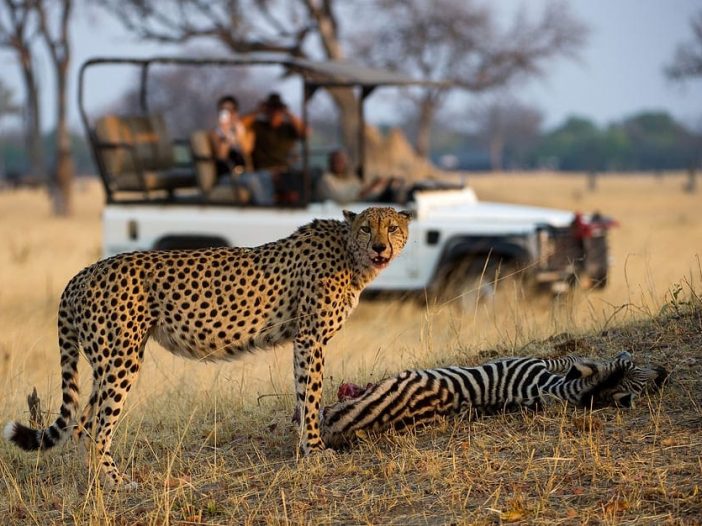
- Highly discounted rates at many top camps coupled with well-priced flying and road transfers
- Minimum number of nights reduced down from 6 nights to 5 nights! No maximum numbers of nights – mix and match!
- No single supplement on accommodation or flying (except Malawi)
- Many accommodation rates reduced, particularly in Namibia and Zimbabwe
- Increased age limits apply to child rates. Children 6 to 16 years sharing in a family room with full paying adults, pay 50% of the adult rate
- Travel to key areas of southern Africa and combine a vast range of complementary experiences
- Superb rates NOW included for Wilderness Touring in Cape Town
Validity: Valid from 1 November 2013 up to and including 15 April 2014 (excludes the festive season 20 December 2013 – 10 January 2014)
Botswana
Minimum 5 night stay in one country or a combination of countries!
Banoka Bush Camp: Okavango Delta
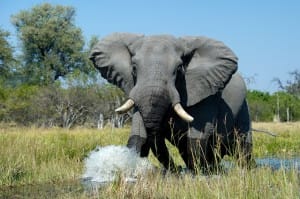
Banoka Bush Camp is named in honour of the River San, or Banoka, ancestors of the Khoi and the earliest settlers of the Okavango Delta. It is situated in the Khwai Development Trust Community Concession, on the banks of the Khwai River in the north-eastern corner of the Okavango Delta adjoining the Moremi Game Reserve. The Khwai River is the northernmost ‘finger’ of the Delta’s alluvial fan. Here you can discover one of the most diverse areas in northern Botswana, with a wealth of wildlife to be seen on drives, walks and traditional mokoro rides (water level dependent).
Banoka Bush Camp is built along the tree line overlooking a lagoon; the whole camp is raised off the ground to take in the view. Accommodation is in ten en-suite tented rooms complete with private verandas. There are two family tents which accommodate two adults and two children each. The main area consists of a bar, lounge, dining area and plunge pool and deck. There is an open campfire area to relax in and discuss the day’s adventures. The camp is 100% solar powered.
You can expect to see excellent sightings of predators including lion, wild dog, spotted hyaena and African wild cat. Huge herds of buffalo along with elephant, hippo, roan, tsessebe, reedbuck, waterbuck and red lechwe to name a few are abundant in the area. Spectacular birding opportunities also abound, with some 450 species recorded.
Banoka Bush Camp is easily combined with the Linyanti regions and Central Kalahari Game Reserve to provide a comprehensive Botswana experience – and in summer it is simply unbeatable as a wildlife destination.
Kwetsani : Okavango Delta
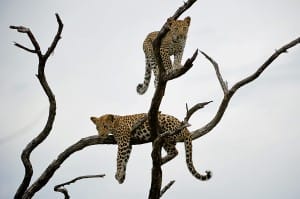
Located in the central region of the Jao Concession, Kwetsani Camp has access to the vast open floodplains and some of the most stunning vistas of the Okavango Delta. To the north of Jao Camp on the same floodplain system, both camps are surrounded by beautiful islands fringed by riverine forests.
Kwetsani Camp consists of six furnished ‘tree-house’ chalets, each with its own en-suite bathroom, which are an open, airy accommodation of thatch, wood, glass and canvas. The dining room, lounge and drinks area are constructed under a large, cool thatched roof and offer incredible vistas of the surrounding floodplains dotted with lechwe, wildebeest and other plains game. Guests can also watch this wildlife from a communal pool or simply the comfort of their own rooms.
Kwetsani Camp offers excellent land and water activities dependent on the annual flood levels of the Okavango Delta. Game drives, as well as breathtaking wildlife viewing by mokoro are on offer. There are also two platform game viewing hides in the concession.
Lion, leopard, wild dog, cheetah, tsessebe and red lechwe are among the major game attractions at Kwetsani Camp, while hippo, sitatunga antelope and crocodile reside in the deeper, permanently lily-filled lagoons of the area. Nocturnal animals such as porcupine, aardwolf, serval, large spotted genet and lesser bushbaby can be observed on the night drives (water levels permitting).
Tubu Tree: Okavango Delta
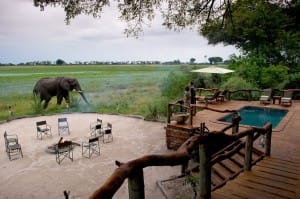
Located on Hunda Island, the largest area of permanently dry land in this region of the Okavango Delta, Tubu Tree Camp is surrounded by palatable grasses which attract a variety of plains game species. A mosaic of interconnecting diverse habitats, ranging from dry Kalahari sandveld to mopane and riverine forest edging on permanent waterways, ensures diverse and spectacular game viewing.
Tubu Tree Camp is built in traditional style, with elevated wooden walkways connecting eight (as of July 2013) tents on raised platforms – each with picturesque vistas of the floodplain from a private front deck. En-suite bathroom facilities and an outdoor shower are standard. A family unit consisting of two adjoining tents with separate bathrooms and a shared lounge will be available from July 2013.
With commanding views of the wonderful scenery, the main dining, lounge areas and pool are also raised, while an open bar area is shaded by the canopy of a large marula tree.
Wildlife seen around Tubu Tree Camp includes elephant, lion, Burchell’s zebra, red lechwe, southern giraffe, tsessebe, and blue wildebeest on the floodplains. Kudu, impala, bushbuck and leopard are also seen in the forested areas. The variety of bird life is impressive, with dry-land species seen on the large islands and a multitude of wetland birds seen on the floodplains and waterways.
Throughout the year day and night game drives in open 4×4 vehicles are available. There are two platform hides in the concession, offering incredible up-close viewing, or an opportunity to sleep out under the stars. During winter, the water levels around Tubu Tree Camp rise and the floodplains become covered with water (normally May to late September). This allows for a wide range of water activities from boating and fishing to mokoro trips.
Little Tubu: Okavango Delta
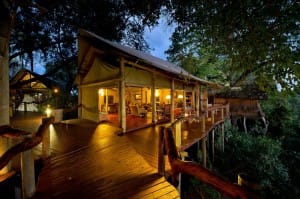
Little Tubu is located on the remote Hunda Island, the largest dry landmass in the Jao Concession. Hunda Island supports a patchwork of diverse habitats, ranging from Kalahari sandveld to mopane and acacia woodland to riverine forests on the permanent Okavango Delta channel systems. These in turn support a variety of ecological communities, which ensure a varied and exciting game viewing experience.
Nestled amongst a canopy of trees overlooking a seasonal riverbed, Little Tubu offers an exceptional and intimate bush experience for a maximum of six guests.
With three traditionally styled tents on raised wooden platforms, each has a private viewing deck, an outdoor shower and en-suite bathroom facilities.
Elevated walkways link the tents to the main dining, bar and pool areas that are designed to blend seamlessly into the surrounding environment and maximise the spectacular views.
Wildlife seen around Little Tubu includes elephant, lion, Burchell’s zebra, red lechwe, southern giraffe, tsessebe, and blue wildebeest on the floodplains. Kudu, impala, bushbuck and leopard are also seen in the forested areas. The variety of birdlife is impressive, with dry-land species seen on the larger islands and a multitude of wetland birds seen on the floodplains and waterways.
Throughout the year, day and night game drives in open 4×4 vehicles are available. There are two platform hides on the Jao Concession, offering incredible up-close viewing or the unique opportunity to sleep out under the stars. During winter, the water levels around Tubu Tree rise and the floodplains become covered with water (normally May to late September). This allows for a wide range of water activities, from boating and fishing to mokoro excursions.
Vumbura Plains (Premier): Okavango Delta
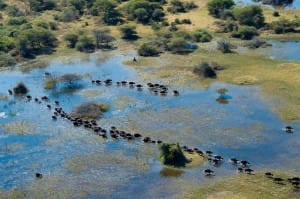
Vumbura Plains Camp is a luxury camp situated in a private concession in the extreme north of the Okavango Delta. The concession, which is leased from the neighbouring community, includes a wide variety of habitats, diverse wildlife and an enormous traversing area of 60,000 hectares.
Vumbura Plains Camp comprises two separate seven-roomed satellite camps, each with its own raised dining, lounge and bar area tucked beneath a canopy of cool, shady, indigenous trees . Magnificent vistas across the Okavango Delta floodplains are a feature. A star-gazing deck with comfortable cushions protrudes into the floodplain, a place to gaze upwards, or a convivial camp fire setting.
Vumbura Plains Camp is unlike any safari camp you will have seen before. Each large, luxurious room is raised off the ground on wooden decks and each comprises a bedroom, lounge, shower and full en-suite bathroom. Outdoor showers are standard. It is open on three sides, and the billowing curtains between the various areas create the sense of a yacht floating through the floodplains. Each room also has a plunge pool and ‘sala’ – a comfortable area to lie and relax, watching the waving grasses of the floodplain.
What makes the Vumbura concession so unique is its position on the extreme north of the Okavango Delta. This position encompasses such a wide variety of habitats and species that it has representatives of just about every animal that occurs in the Okavango biome.
Vumbura Plains Camp offers both land and water activities, principally nature viewing in varied habitats in open 4×4 vehicles, nature walks, mokoro trips and boat excursions. Whilst exploring the spectacular ecology of this area, one can enjoy close-up viewing of lion, leopard, elephant, cheetah and buffalo along with all the plains game.
Birding around Vumbura Plains Camp is incredible – with both variety and prolific numbers. The Vumbura area is possibly the only area in the Okavango Delta where one can see red lechwe (an animal that inhabits the fringes of the waterways) and sable antelope (an animal that prefers the dry countryside) on the same game drive.
Jao Camp (Premier): Okavango Delta
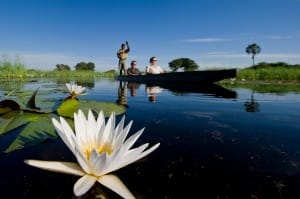
In the central region of the concession, vast open floodplains provide some of the most stunning scenery Botswana has to offer. Jao Camp lies in the southern side of the plains, an area with beautiful islands fringed with riverine forests.
Jao Camp has nine spacious, beautiful tents, each individually handcrafted. These twin-bedded canvas and thatched rooms are situated beneath a canopy of shady trees and have en-suite facilities, as well as an outdoor shower for the more adventurous. Built on raised decks, each has a private sala for afternoon siestas and offers wonderful views of the spectacular surrounding floodplains of Botswana. In addition to the lounge and dining area, there are two plunge pools and an outdoor boma for dining under the stars, complemented by wines from an excellent wine cellar. Jao Camp also has a spa where a wide range of massage therapies are offered. For more information please visit www.jaospa.com.
Mekoro, boat trips, fishing, day and night game drives and birding are usually on offer all year round due to the abundance of wildlife in Botswana. There are two platform hides in the concession. During an unusually high flood season, game drives begin by boating out to a nearby Hunda Island where the vehicles are waiting, and the drive begins from there. Huge herds of red lechwe can be seen, followed by their primary predator – prides of lion. Other game typical of Botswana include elephant, buffalo, leopard, tsessebe, zebra and wildebeest, hippo and crocodile. Many bird species are resident such as Meyer’s Parrot, African Harrier Hawk, Black Heron, Coppery-tailed Coucal, Malachite Kingfisher, Hamerkop and Black Crake being some of the avian treasures found at Jao Camp.
Abu Camp (Collection): Okavango Delta
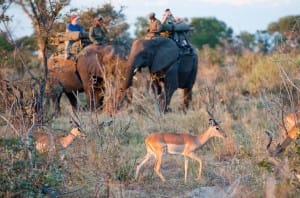
Abu Camp offers a rare African experience that showcases the magnificent wildlife and landscape of the Okavango Delta; a safari that will transform your perceptions of elephants, wilderness, and life itself.
As a guest of Abu Camp, you are invited to walk with and ride elephants, to get a glimpse of their world and learn about their lives. Becoming part of an African elephant herd is an extraordinary privilege that we seek to share with those who visit us.
Pioneered in the early 1990s, and named after a much-mourned bull elephant, Abu Camp has been running for 20 years, and as such is the original elephant safari experience in Africa.
The vast 180,000 hectare (450,000 acre) private and exclusive Abu Concession is set within the unspoilt pristine wilderness area of the Okavango Delta. As the largest inland delta on the planet, the Okavango and surrounding areas of northern Botswana hold more elephants than any other area in Africa.
Abu Camp, while never forgetting its environmental footprint, aims to provide the very best in privacy, location, accommodation and service. Allowing all who visit to absorb themselves in a whole new world, the camp is a haven of peace and tranquillity, immersed within the natural rhythms of the bush.
Jacana Camp: Okavango Delta
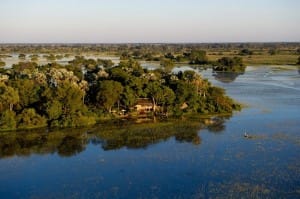
Jacana Camp is situated in the private Jao Concession on the Moremi Game Reserve boundary in the Okavango Delta, Botswana.
Located on a beautiful island and surrounded by the seasonally inundated floodplain and papyrus swamps, Jacana Camp consists of five Meru-style tents built on raised wooden decks to facilitate its panoramic views of the Okavango Delta. Each tent has an enclosed en-suite bathroom. The main dining area is on an elevated platform between two magnificent sycamore fig trees and surrounded by dense wild date palms. Jacana Camp also has a cosy drinks and lounge with an area for an open fire under the stars; and a plunge pool for cooling off in the midday sun.
Activities at Jacana Camp include mokoro trips, throughout the year and game drives during September and May when the floodwaters have receded. There are also two platform hides within the Jao Concession.
Jacana Camp is set in one of the most densely populated wetland areas for sitatunga and red lechwe. All the big animals can be found regularly in the area: including elephant, lion, leopard and buffalo. Wildlife concentrations within this part of the Okavango Delta depend on the water flow and volume and thus change from season to season. Birdlife is abundant; enthusiasts can spot Pel’s Fishing-Owl as well as African and Lesser Jacanas and a host of other Okavango specials such as Slaty Egret, African Pygmy-Goose and Western Banded Snake-Eagle.
Xigera Camp: Okavango Delta
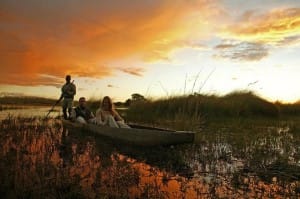
Xigera Camp (pronounced Keejera) is located on a riverine island right in the heart of the Okavango Delta. This part of the Moremi Game Reserve is a true wetland paradise, with Xigera Camp surrounded by deep channels and lush vegetation.
Xigera Camp consists of ten luxuriously furnished tented rooms – each with en-suite facilities and an outdoor shower. Raised on wooden platforms and walkways, each tent offers superb views of the seasonal Okavango Delta floodplains and the lagoon. The feeling of living in the midst of a riverine forest is one of the features of Xigera Camp.
Meals and evening drinks are enjoyed in the lounge, pub and dining area overlooking a permanently flowing channel or under the stars in a traditional African boma. For those hot days there is a small plunge pool in which to cool off.
Guests are sometimes treated to close-up views of lion or leopard using the footbridge connecting Xigera Camp’s island to the next! The camp “newspaper” (a sand pit built into the bridge to capture paw prints) is “read” each morning and provides information on unseen nightly visitors to camp.
Permanent water year-round allows an unparalleled variety of activities such as mokoro trips, game drives and motorboat outings. Xigera Camp is the only camp in the area – ensuring total privacy.
A mokoro ride is mandatory at Xigera Camp. On this traditional dug-out canoe, the only sounds are the rustling of the wind through the reeds, the lapping of the water against the boat, and the call of the African Fish-Eagle. The blue of the sky is mirrored in the water, broken only by large round water lily leaves and their stunning purple and white flowers.
When water levels permit, game drives are an attraction. During drier years, drives are available throughout the year, but if there has been a very high flood, drives take place only from late September to April.
Xigera Camp is a delight for birdwatchers, with Pel’s Fishing-Owl, African Skimmer, Slaty Egret, Wattled Crane and a host of raptors, other waterbirds and colourful kingfishers to be seen. An abundance of wildlife includes red lechwe, lion, and spotted hyaena.
Kalahari Plains Camp: Central Kalahari Game Reserve
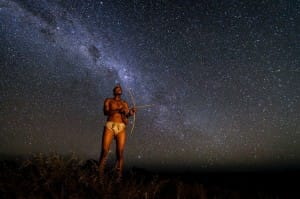
Kalahari Plains Camp is situated in a remote part of the diverse and productive Central Kalahari Game Reserve (CKGR) and offers some of the best summer wildlife viewing opportunities in Africa. Located in the Kalahari Desert biome in the central part of Botswana, at 5 million hectares this reserve is the largest conservation area in the country and one of the largest in the world. The CKGR is home to the legendary Kalahari black-maned lion as well as some of the world’s best cheetah viewing.
Kalahari Plains Camp is perfectly situated overlooking an immense pan with endless horizons and beautiful skies. It comprises 10 en-suite canvas units with a sleep-out above each from which to enjoy moonlit or star-studded nights. The main area consists of a lounge and dining area with an inviting swimming pool and deck area. The tents and main area are all raised off the ground to catch the breeze and take in the sweeping, spacious views across the Kalahari. Solar power provides all the electricity and hot water in the camp – making Kalahari Plains a 100% solar-powered camp – and innovative insulated canvas walls and roof keep the temperatures inside the units comfortable.
Thanks to the diversity of habitats, healthy game populations move through the area and are present to a greater or lesser degree all year round, but with the advent of the summer rains (end of November to April) the desert truly comes to life. Short grasses sprout in the pan systems and fossil riverbeds, attracting a plethora of plains game such as springbok and gemsbok which converge in their hundreds and thousands to graze. Wildebeest, steenbok and red hartebeest join in the feast, and all these are followed in turn by predators such as lion, cheetah, and jackal. All this is perfectly complemented by lush green landscapes, floral displays and endless skies often providing the life-giving rains that transform the area.
At other times, the Kalahari is more typically a dry desert-type system, when game viewing moves into the vegetated dune belt and pan systems surrounding the valleys. General game still easily seen includes gemsbok, springbok, red hartebeest and steenbok as well as their predators such as lion, one of the highest concentrations of cheetah in southern Africa, leopard, brown hyaena and even caracal. Small predators also found here are black-backed jackal, meerkat (suricates), Cape fox, honey badger and a myriad mongoose species. Some 220 bird species have been recorded to date.
Guided game drives unlock the fascinating wildlife treasures found in this wonderful arid area. Visits to Deception Valley or even further afield are longer excursions that are well worthwhile, as the wildlife moves to different parts of the Park.
DumaTau Camp: Linyanti
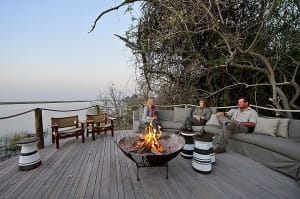
DumaTau Camp is a ten-roomed (eight twin and two family) luxury tented camp located in the private 125 000-hectare Linyanti Wildlife Reserve that borders the western boundary of Chobe National Park in northern Botswana. It is situated close to the source of the Savute Channel on Osprey Lagoon, one of the many lagoons within the Linyanti Swamp system, and between two elephant ‘corridors’ – all of which makes for a plethora of wildlife on game drives along the Savute.
DumaTau Camp, rebuilt completely in 2012, is raised off the ground to take advantage of the sweeping dramatic river views. Each en-suite tent is spacious, spreading out under a canvas roof, with a wraparound clear-storey window that allows for dramatic views of the riverfront, as well as the sounds of Africa, all from the comfort of the room. There is an airy and expansive dining and lounge area, and a guest bathroom, all overlooking the lagoon and its denizens.
Importantly, in line with the Wilderness 4Cs ethos, DumaTau Camp operates completely on solar energy, for hot water, lighting and other energy needs, and is built of FSC-standard timber. In addition, the camp has water-wise waste removal and uses green and thermal insulating materials.
The region has all the habitat diversity to make it a haven for wildlife, and is well-known for its elephant concentrations as they congregate along the waterways and lagoons during the dry winter months. General wildlife viewing is excellent year round including impala, wildebeest, red lechwe, Burchell’s zebra, giraffe, Cape buffalo, chacma baboon, vervet monkey, and warthog. Predator sightings of lion, leopard, cheetah, wild dog and spotted hyaena are good.
Wildlife viewing is the primary activity at DumaTau Camp, either on day and night game drives or while on foot and on the water (levels permitting). Short nature walks can be taken along the Linyanti River and Savute Channel, while the camp’s barge takes visitors along the waters of the Linyanti, with hippo and waterfowl alike to entrance. There are also a number of platforms and hides from which to view and photograph animals and birds. One of the best hides is right at the source of the Savute and many species of game and birdlife can be seen from this hide.
Savuti Camp: Linyanti
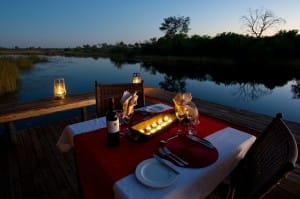
Savuti Camp is situated in an isolated part of the Linyanti Concession along the Savute Channel in northern Botswana. The site of Savuti Camp is about 17 kilometres ‘downstream’ from the Zibadianja Lagoon – the source of the Savute Channel. The Channel stopped flowing between 1980 and 2008; during this time it was an unusual and productive ribbon of grassland that served as a corridor and feeding ground in the surrounding woodland for a wide variety of herbivores.
In 2008, the Savute Channel once more became a deep, clear waterway harbouring hippo and aquatic life with myriad varieties of waterbirds. Wildlife, from plains game to a plethora of predators, has had to adapt to a new source of water and all the opportunities and menaces it has brought with it. For different species the Savute Channel has become a place of refuge, an obstacle, an unrivalled food source, a navigational aid, a larder, a playground, and a graveyard. It is impossible to say yet whether the waters will persist or begin to recede in earnest as much of this will depend on the next summer rains – but while it lasts, at Savuti Campthere are front-row seats for each drama that is played out.
With two-thirds of the Savute Channel located in the concession, Wilderness guests have private and exclusive access to the abundant game and the natural and geological changes that are occurring on a daily and seasonal basis.
This intimate camp’s en-suite accommodation is in seven large walk-in tents that are raised off the ground and face onto the Savute Channel. From the camp’s thatched dining area, a plunge pool and large viewing area with fire pit extend outwards on raised wooden decks, providing a wonderful view of the Savute Channel and its wildlife.
Explore the Savute Channel and its environs through day and night game drives, nature walks with a guide (on request), and several well-positioned hides for safe, up-close animal viewing. Savuti Camp’s former ‘wood-pile hide’ in front of camp is now part of the flowing Savute and famous for spectacular elephant viewing in the drier winter months.
Game concentrations here are high, particularly in the winter dry season, and apart from abundant plains game, species such as roan and sable antelope, southern giraffe, lion, leopard, cheetah, spotted hyaena, black-backed jackal and wild dog may also be encountered. In winter, this area can also be excellent for the sought-after aardvark and aardwolf, which are big ticks on anyone’s mammal lists!
Kings Pool (Premier): Linyati
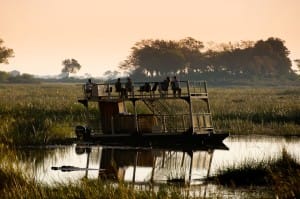
Kings Pool Camp is located in the Linyanti Wildlife Reserve, a vast private concession in the northern part of Botswana, on the western boundary of Chobe National Park. The accommodation here is luxurious, the wildlife spectacular.
Kings Pool Camp has nine well-appointed tents (including one family unit) of canvas and thatch. Each has a large bedroom area, lounge, private plunge pool and ‘sala’. The spacious en-suite bathrooms are tiled with double showers and hand-basins – as well as an outdoor shower for those who wish to shower close to nature! The lounge, dining room and pub areas are on expansive raised decks. There is also a communal pool and an open-air ‘kgotla’ for dining under the stars.
Kings Pool Camp overlooks the Linyanti River and the oxbow-shaped Kings Pool Lagoon, apparently named after a Scandinavian monarch who spent a number of nights camping out on its banks – long before any camp was built here.
The Linyanti Wildlife Reserve has abundant wildlife in a wide variety of species, but is most noted for its very large elephant population which can reach enormous densities during the dry winter months. Other game is abundant, such as impala, lechwe, kudu, zebra, giraffe, buffalo and bushbuck, and their predators: lion, leopard, cheetah, wild dog and spotted hyaena. Rarer species such as sable and roan antelope also emerge from the woodlands during the dry season.
Apart from the simple appeal of watching the elephants at the water’s edge from the luxury of the raised decks of Kings Pool Camp, spectacular wildlife viewing is available on day and night game drives and walks. Allowing for water levels, seasonal barge cruises along the Linyanti River are also on offer. The reed and papyrus swamps are ideal for numerous and diverse species of birds and are a magnet for game in the dry winter months.
Kings Pool Camp is famed not just for the sights, but also the sounds of wildlife all around. For this reason the camp has two hides. One is located at the western end of the camp where one can spend one’s entire siesta time watching game come down to drink. The other is an original underground hide, with the water at eye-level. Seeing massive elephant feet and trunks almost within touching distance while safely inside is an extraordinary experience.
Namibia
Minimum 5 night stay in one country or a combination of countries.
Kulala Desert Lodge: Sossusvlei Region
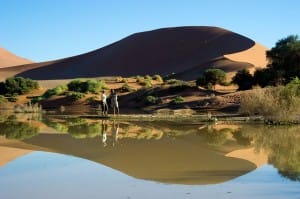
Kulala Desert Lodge is located within the arid Namib Desert on the 37 000-hectare private Kulala Wilderness Reserve, and is closest to the iconic dunes of the Sossusvlei.
Accommodation at Kulala Desert Lodge comprises 23 thatched and canvas “kulalas” (“to sleep” in Oshiwambo) with en-suite bathrooms and verandas. This includes three family tents which can accommodate two adults and two children.
Each unit is built on a wooden platform to catch the cooling breezes and has a deck on the flat rooftop where bedrolls are placed for guests to sleep under the myriad stars that Namibia’s clear skies portray.
Kulala Desert Lodge has a main area, lounge, bar, dining area, plunge pool, and wrap-around veranda overlooking the waterhole – a perfect location to view and photograph the desert vista. The overall setting is a true delight to the senses, bringing together the rhythm of Namibia, wholesome meals and intimacy. A waterhole in front of camp attracts a number of local wildlife (such as gemsbok, springbok, ostrich and jackal) and provides a perfect location to view and photograph the desert scenery.
Activities at Kulala Desert Lodge revolve around early morning guided nature drives to the spectacular dunes of Sossusvlei through the private gate on the Tsauchab River. World-famous Sossusvlei is an enormous clay pan, flanked by the famous sand dunes that stand out starkly against the blue sky and flush red in the early morning sun. These dunes have developed over millions of years, the wind continuously transforming the contours of this red sand sea. The ‘vlei’ itself only fills after rare, heavy rainfalls when, in a complete turn-around, it becomes a spectacular turquoise lake.
Nature drives, walks and eco-sensitive, guided quad-biking are also offered through the private Kulala Wilderness Reserve to take in those incredible views and to catch a glimpse of the denizens of the desert.
Another option, at an extra cost, is early morning ballooning, beginning at first light. The balloon safari offers a truly unique experience to soar silently above the magnificent sand dunes and desert, with a champagne breakfast being served at your landing site.
Little Kulala (Premier): Sossusvlei Region
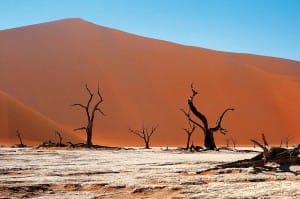
Little Kulala is a luxurious desert retreat situated in the private 37 000-hectare Kulala Wilderness Reserve – the gateway to Namibia’s Sand Sea with its towering dunes and clear starry skies.
Accommodation at Little Kulala consists of 11 climate-controlled, thatched “kulalas” (the word means ‘to sleep’) which merge impeccably into the timeless desert landscape, with exquisite fittings and fixtures, and innovative bleached decks – each with a private plunge pool. Each kulala has a rooftop ‘skybed’ for romantic stargazing, with both indoor and outdoor showers.
Little Kulala features an elegant entertainment area which includes a library, wine cellar, craft boutique, lounge and dining areas. Dining under the clear Namibian skies is a highlight. The interiors have been designed to provide an all-natural and unique experience in this most beautiful environment. The extensive use of neutral colours, gorgeous textures and natural light reproduce the soothing pastel tones of the desert. Pure linens, cottons and mohair dyed with natural vegetable dyes all make for a very organic camp which takes its inspiration from its surroundings, notably from the magnificent Dead Vlei in the middle of Sossusvlei. The overall mood and feel is cool, serene, organic and sheltering.
Desert-adapted wildlife such as ostrich, springbok and gemsbok eke out an existence and are sparsely distributed around Little Kulala. Smaller creatures such as bat-eared fox and aardwolf can be seen at night in the cool desert air. One bird, the aptly named dune lark, has its entire global distribution limited to the area, so dependent is it on the area’s characteristic sands.
Activities at Little Kulala start with morning guided drives to the spectacular towering dunes of Sossusvlei, through a private gate into the reserve. Sossusvlei is situated within the Namib Desert, the oldest desert in the world, which itself is part of the Namib Naukluft National Park that stretches 400km south of Walvis Bay and is sandwiched between the west coast and the escarpment that runs parallel more than 100km inland. Its huge dunes and flat valley floors make up the archetypical view of the Namib that is world famous.
Guided drives and walks are also offered on the private Kulala Wilderness Reserve with incredible views, desert-adapted wildlife and plants.
Another option, at an extra cost, is early morning ballooning, beginning at first light. The balloon safari offers a truly unique experience to soar silently above the magnificent sand dunes and desert, with a champagne breakfast being served at your landing site.
Damaraland: Damaraland Region
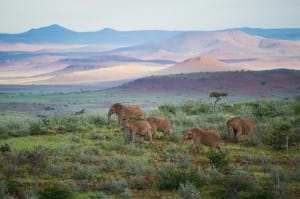
Damaraland Camp is situated in the Huab River Valley, arguably the most pristine wilderness area in Namibia, 90km from Torra Bay in the Torra Conservancy. It is lauded as one of the country’s best camps, with sensational views of the surrounding desert plains, ancient valleys and soaring peaks of the Brandberg Mountains.
Winner of the 2005 WTTC Tourism for Tomorrow Conservation Award, the eco-friendly construction of Damaraland Camp has merged new technology with ancient methodology in an incredibly inventive manner. Another unique feature of this sustainable ecotourism venture is that it is owned and largely run by the local community – who have injected their own distinctive optimism and cheerful nature into the Damaraland Camp experience. This unusual flavour comes from the mixed heritage of the local peoples, which include Nama-Damara, Herero, Owambo, and the displaced Riemvasmakers of South Africa.
Accommodation at Damaraland Camp consists of 10 adobe-styled, thatched units each raised on individual wooden decking – part of which extends out to form a large viewing deck with magnificent vistas. Recently refurbished, each tent has en-suite facilities (shower only), a walk-in dressing area and built-in fan. Mosquito repellent is also provided.
The spacious, thatched living area features a restaurant and bar, complete with fireplace. Evening meals at Damaraland Camp are often prepared over an open fire and served out in the open in an area near to the camp lit by an assortment of small lanterns. The swimming pool is conveniently sited next to the bar. An open campfire and outdoor ‘boma’ can be enjoyed during calm evenings, with superb stargazing in the crystal-clear night skies.
Large game is not concentrated year-round here, with the natural cycle of rainfall dictating the seasonal movement of wildlife along the Huab River.
Activities at Damaraland Camp revolve around exploring the Haub River system, featuring guided nature drives and walks. Morning and afternoon drives in search for desert-adapted elephant are a great favourite. Gemsbok, greater kudu, springbok, and occasionally lion, cheetah, elephants and black rhino can be spotted. Interesting flora such as euphorbias and shepherd’s trees can be viewed on the way to some of Africa’s best known rock engravings, including the famous Twyfelfontein etchings (subject to availability and at additional cost).
Doro Nawas Damaraland Region
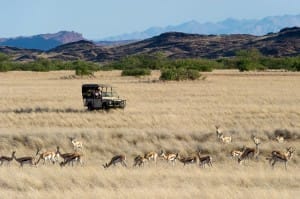
Doro Nawas Camp is located in the dry Aba-Huab River Valley, within the Doro !Nawas Conservancy in central Damaraland, and commands spectacular views of the Etendeka Mountains to the north and the red sandstone cliffs of Twyfelfontein in the south.
Accommodation at Doro Nawas Camp consists of 16 units: a mix of natural stone and canvas walls with wood and glass doors, shaded by a thatch roof. Each unit, is designed to blend into the surrounding scenery, and consists of a bedroom, en-suite bathroom (with outdoor shower) and a veranda for stargazing or sleep outs.
The main building of Doro Nawas Camp is perched atop a sparse, rocky knoll and offers unspoilt panoramic views. This diverse and dramatic landscape varies from tabletop outcrops, small canyons and dry riverbeds, to savannah and grassland vistas. The main area is made up of indoor and outdoor dining areas, pool area, bar and local curio area. A staircase to the roof allows for relaxing sundowners and stargazing.
Doro Nawas Camp provides an excellent base for self-drive and fly-in guests. Activities revolve around extensive game drives and exploratory hikes through this unparalleled landscape. A trip to the fascinating Twyfelfontein San art engravings is not to be missed. Namibia’s first World Heritage Site, Twyfelfontein has the largest collection of petroglyphs (prehistoric rock art) in Africa. Visit the Damara Living Museum and learn about the fascinating traditional culture of the Damara people. This combination of Africa past and present makes for a truly unique and unforgettable experience.
Wildlife viewing at Doro Nawas Camp concentrates on the game found in the riverbed and along the valleys that fill with floodwaters during particularly good rainy seasons. There are no large concentrations of wildlife, but this arid environment is home to desert-adapted elephant, gemsbok, springbok and variety of other species such as bat-eared fox. This includes the occasional glimpse of the endangered black rhino and cheetah. Birdlife is excellent with several Namibian endemics, such as Damara Hornbill, Carp’s Tit and Rüpell’s Korhaan.
A visit to Doro Nawas Camp is also a wonderful opportunity to contribute to economic empowerment of the local community while enjoying a luxury safari experience.
Ongava Lodge: Etosha Region
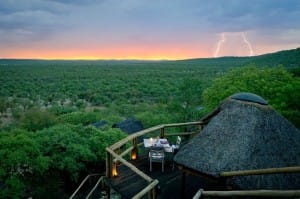
Ongava Lodge is cleverly constructed on a small hill in the Ongava Game Reserve against the southern boundary of the Etosha National Park. From up here guests can enjoy a host of thirsty wildlife congregating around the waterhole.
Accommodation at Ongava Lodge consists of 13 chalets and 1 family room, attractively built out of brick, rock and thatch. Each chalet has an en-suite bathroom with flush toilet, shower and double hand basins. Air-conditioning and overhead fans keep guests cool in summer. Mosquito nets are fitted to the windows and each room features a tea/coffee station and a safe. The rooms have glass-fronted doors which lead out onto a private, covered veranda, overlooking the plains.
There are impressive views of the waterhole and surrounding plains from the main lounge, bar and dining areas. Meals are either served in the main dining area under thatch or on the dining deck under the stars.
Ongava Lodge was listed on the Condé Naste Traveller’s Gold Reserve List for 2005.
Etosha National Park is Namibia’s premier wildlife destination and one of Africa’s largest game reserves. Large herds of wildlife teem around the waterholes and the endless plains offer breathtaking vistas. The Ongava Game Reserve shares a boundary with the Etosha National Park.
Activities at Ongava Lodge revolve around day and night wildlife-viewing drives, visiting hides that overlook waterholes and walks with experienced guides. A hide at the camp waterhole provides superb photographic opportunities. The Ongava Game Reserve features all the characteristic wildlife of the area, with both desert-adapted black and white rhino to be seen as well as lion.
Game drives and daytrips into the easily accessible Okaukuejo area of Etosha National Park are rewarding, with sightings of lion, elephant, gemsbok, springbok, red hartebeest, and white and black rhino. Guests at Ongava Lodge share a dedicated guide and Land Rover, ensuring the best possible nature experience at one of Africa’s great wildlife destinations.
The Ongava Game Reserve is unique in that it is one of the few private game reserves in southern Africa where there is a chance of seeing both black and white rhino. For those who enjoy close wildlife encounters, tracking white rhino on foot with a guide is a highlight not to be missed.
Serra Cafema (Premier):Kunene Region
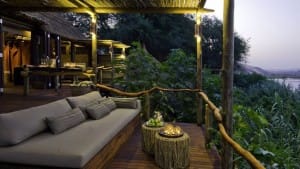
Serra Cafema is a very beautiful and elegant camp situated right on the river. Behind it is he Kaokoland with sandy valleys and huge inselbergs. A safari destination which is unique.
You almost feel that you are at the edge of the earth – breath-taking views!!
The camp has open decks, beautifully designed and equipped rooms. The eight canvas and wooden chalets provides for only 16 visitors within miles and miles.
South Africa
Minimum of 3 nights.
Rocktail Beach Camp : iSimangaliso Wetland Park, Zululand
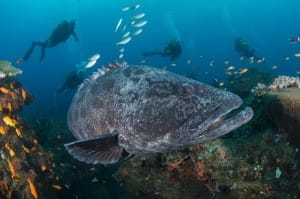
Rocktail Beach Camp is set back in and shaded by the sanctuary of the lush Maputaland Coastal Forest covering the ancient dunes that make up the edge of South Africa’s KwaZulu-Natal coast. With the Maputaland Marine Reserve just offshore and the beach a brisk 20-minute walk from the camp, there are world-class diving and snorkelling, remote, unspoilt beaches and other beach adventures to be had.
The camp consists of 17 rooms all of which with en-suite bathrooms, open-feel indoor shower and overhead fans. Seven of these are family units with a shared bathroom and two bedrooms for two adults and two children. A honeymoon unit has wonderful views over the ocean and dune forest.
Rocktail Beach Camp also has a central dining room, bar and lounge with large wrap-around veranda. A raised viewing deck just off the veranda has wide views that extend out to the ocean. The camp’s main area has a wine cellar, large pool, curio shop and children’s playroom, complete with board games and other fun activities for families.
From a scuba diving perspective, Rocktail Bay is unique. Not only is the diving conducted within a Reserve and World Heritage Site along unspoiled reefs, but divers have the luxury of knowing that they alone have access to these sites and are the only underwater visitors along this stretch of the coastline.
Zimbabwe
No combination of camps required, minimum 3 nights.
Recommended in conjunction with Botswana and/or Zambia
Little Makalolo: Hwange National Park
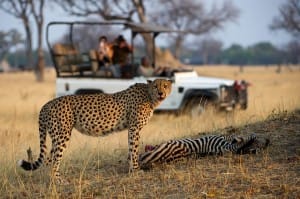
Little Makalolo Camp lies in the heart of Hwange National Park, in one of its best game viewing areas, overlooking a vibrant waterhole. The camp’s six rooms have en-suite facilities, with both indoor and outdoor showers. Solar power is used for electricity ensuring a lighter environmental footprint. The living areas include a dining room, lounge, plunge pool and an open fire area for those convivial evening fireside tales. There is a log pile hide overlooking the waterhole in front of camp where guests can enjoy wildlife viewing during the siesta hours.
Activities at Little Makalolo Camp centre on open 4×4 Land Rover game drives and guided nature walks throughout the Makalolo concession. The area’s large number of waterholes attracts game in both quantity and variety, especially in the winter months when Hwange is literally home to a Noah’s Ark parade of animals as they come down to quench their thirst.
Makalolo is one of the best areas for seeing impressive herds of buffalo and elephant as well as apex predators such as lion, leopard, wild dog and cheetah. Other general game is very abundant in the Park.
Bird life in the area is prolific (400+) and varied, with species frequenting teak woodlands as well as those more typical of the drier Kalahari being present.
Davison’s : Hwange National Park
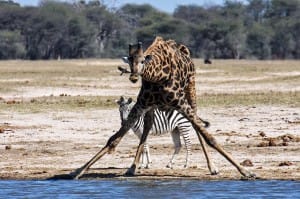
Davison’s Camp lies deep in Hwange National Park, in the south-eastern Linkwasha Concession – one of the best game viewing areas of the entire Park. It is a classic African tented camp, with the units tastefully hidden beneath a grove of false mopane trees, overlooking a waterhole and open plain.
Named after the founder of Hwange National Park and its first warden, Ted Davison, this camp, with its 8 tents and a family tent, offers a wonderful bush experience. Both the tents and the separate main area, comprising a lounge, dining room, and open campfire area and pool, look out over the productive waterhole.
Activities at Davison’s Camp include game drives in open 4×4 vehicles, or guided walks in the early mornings, while during the siesta hours, guests can view wildlife coming down to the waterhole to drink from their tent veranda or the main area.
Game viewing is productive year-round in the Linkwasha Concession and wildlife frequently encountered here includes lion, large herds of elephant, buffalo, leopard, white rhino, spotted hyaena, southern giraffe, sable, blue wildebeest, impala, common waterbuck and reedbuck. There are a number of large, open plains areas which make for excellent game viewing; in summer, wildebeest, zebra and eland are found in abundance here, while in winter the waterholes are magnets around which elephant in enormous numbers congregate to drink.
Bird life in the area is prolific (400+) and varied, with species frequenting the teak woodlands as well as those typical of the drier Kalahari being present.
Zambia
No combination of camps required, minimum of 2 nights.
Recommended in conjunction with Botswana and/or Zimbabwe.
Toka Leya: Livingstone at Victoria Falls
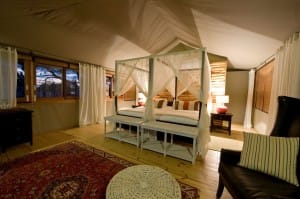
Overlooking the mighty Zambezi River and some of its islands is Toka Leya Camp, consisting of 12 spacious en-suite safari-style tents. Wooden walkways snake between the units and main area, limiting our footprint on this pristine area.
Tent interiors at Toka Leya Camp boast cool wooden flooring, tasteful, uncluttered African décor in earthy hues, climate-control for a cool summer sanctuary, expansive wooden deck from which to soak up the views of the Zambezi River, often to the sights and sounds of birds, elephant and grunting pods of hippo.The islands in front of camp are intriguing and form part of the braided channel of the Zambezi River with several rapids, a main channel and dense vegetation.
The eastern side and main area of camp is under a shady canopy of jackalberry, knobthorn and waterberry trees. The western side is in a more open setting – an ancient baobab tree is the focal point and panoramic Zambezi vistas. Family units are positioned to offer quiet seclusion.
The camp’s dining, lounge and bar areas offer ample space for relaxation and are complemented by an infinity pool, with meals served on the sundeck, the pool deck and dining room all overlooking the Zambezi. The novel pizza oven is a great hit with our younger visitors! A curio shop exhibits a fine selection of local crafts.
Activities (on fully inclusive rate) at Toka Leya Camp include a tour of the Victoria Falls on the Zambian side, game drives within Mosi-oa-Tunya National Park, river cruises, fishing excursions and guided nature walks. Tours of Livingstone town and museum and visits to Mkuni Market and a local village are all outstanding ways of learning about the people and culture of this part of Zambia. Other activities on offer in the area at an additional charge include sunset cruises, helicopter flights, micro-lighting, canoeing, jet boating, and white water rafting.
Game drives into the Mosi-oa-Tunya Park offer sightings of general game species such as buffalo, giraffe, zebra, wildebeest and impala. White rhino have been reintroduced into the park and the occasional predator is also seen. There is rich birdlife here too, including several sought-after species such as African Finfoot, Half-collared Kingfisher, African Skimmer (seasonal), Schalow’s Turaco and Rock Pratincole (seasonal). Good birding can be enjoyed within the confines of Toka Leya Camp itself, on boat cruises and out on game drives.
The Zambezi River offers some fishing opportunities and tiger fishing is an unforgettable challenge for keen fishermen, particularly during the warmer months (October – December). There are several varieties of bream (Tilapia) which are a good catch.
The River Club: Livingstone at Victoria Falls
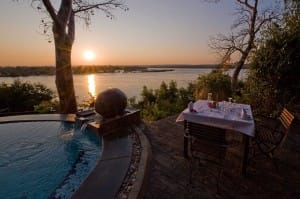
On a magnificent bend on the Zambezi River the majestic River Club and its 10 well-appointed chalets have commanding views over the river into the Zambezi National Park. This old 1940s homestead has been turned into a charming oasis which brings together early years of adventure on the continent and the discovery of The Victoria Falls to the modern world of conservation in Africa.
Its main area, Zambezi House, is a well-appointed residence, with a comfortable lounge, large dining room, impressive library and wide veranda on which breakfasts and teas are enjoyed. Lush gardens (where midday meals are often served) spread out beneath the trees. Soaked in history this lodge draws together many pieces of the puzzle that is Africa today and allows the intrepid traveller the opportunity to delve further into the diversity of life on the continent.
Ten luxury chalets are spread out amongst the riverine vegetation, comprising luxurious bedrooms and en-suite bathrooms, most being split-level. Their originality stems from the fact that one side, although screened, has an open view to the river, so that there is an uninterrupted vista of the Zambezi and its far bank from both bed and bathtub. Each room looks west into glorious African sunsets best viewed from the privacy of the ball and claw bath. All have a concertina screen door or window across the front of the bedroom and/or bathroom.
The swimming pool with is infinity aspect provides one of the best views from any pool in the world.
The River Club also provides a special setting for a wedding away from it all and is an idyllic start or end to any African safari.
Activities at The River Club include informative tours of The Victoria Falls on the Zambian side, game drives within Mosi-oa-Tunya National Park, river cruises, fishing excursions, nature walks and tours of a nearby African village in which to learn about the people and culture of this part of Zambia.
Livingstone is rich in history and certainly worth exploring. It dates back to 1905 when the famous Victoria Falls Bridge, spanning the Zambezi River, was completed in April of that year. Many of the town amenities date back to the early 1900s, including an 18-hole golf course (1908), the country’s first synagogue (1928) and later on its Museum (1953) where many of David Livingstone’s personal possessions are on display today.
Also on offer is a variety of adrenaline-loaded activities: white water rafting, bungee jumping, abseiling, and helicopter flights over the Falls to name a few.
Although The River Club is not a traditional safari camp, elephants can often be seen in the Zambezi National Park opposite and hippo are regularly seen and heard in the river itself. Game drives offered into the nearby Mosi-oa-Tunya National Park is home to an abundance of general game species like buffalo, giraffe, zebra, wildebeest and impala. White rhino have been reintroduced into the park and the occasional predator is also seen. There is rich birdlife here too, including several sought-after species such as African Finfoot, Half-collared Kingfisher, African Skimmer (seasonal), Schalow’s Turaco and Rock Pratincole (seasonal). Good birding can be enjoyed within the confines of The River Club itself, on boat cruises, nature walks and out on game drives.
The Zambezi River offers ample fishing opportunities. Tiger fishing is an unforgettable challenge for keen fishermen, particularly during the warmer months. There are several varieties of bream (Tilapia) that are also a good catch. For the more sporting, try catching them on fly!
Please note: Return road transfers to/ from Livingstone airport included free of charge.
Malawi
No combination of camps required, minimum of 2 nights.
Mumbo Island: Lake Malawi National Park
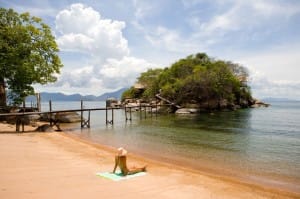
Mumbo Island Camp is named after the pristine, practically deserted tropical island on which it is built. The crystal-clear, warm waters of Lake Malawi National Park boast some 2000 species. It’s no wonder this region of Lake Malawi is often considered the best freshwater diving and snorkelling location on the planet.
Accommodation at the intimate Mumbo Island Camp comprises tastefully furnished, comfortable tents with hot bucket showers and ‘eco-loos’. With an exclusive limit of only 14 guests at a time, Mumbo Island Camp is perched on rocks high above the water – blending with the environment perfectly to create a place of rustic charm and minimal impact. Tucked into the lush foliage, each tent is fully furnished with its own shaded view-deck and hammock. Mumbo Island Camp adheres to strict principles of eco-architecture, so the dining area, bar and water sport gazebo, are all hand built from timber, thatch and canvas.
Unlike most island destinations in the region, Mumbo Island has never been populated by humans and is still in its natural state. This, together with the focus on non-motorised water sports, makes Mumbo Island Camp ideal for the active outdoors enthusiast.
The most popular activities here are diving or snorkelling through the crystal-clear water and lazing in a hammock in the ‘chill-out’ area, contemplating the breathtaking scenery.
Mumbo Island Camp is a PADI registered resort offering beginner, advanced and specialty courses in scuba diving, as well as gear hire and casual dives. Swimming, kayaking, and birdwatching are also popular. For the more intrepid, there are boating and paddling options, exploring the granitic islands in a freshwater Rift Valley lake.
Birders can enjoy the abundant African Fish-Eagles amongst others; and snorkellers can view enormous numbers of the cichlid fish species; these small, colourful fish have adapted to so many variations that they are considered of comparable importance to the Galapagos finches in the study of evolution
Mvuu Camp,Mvuu Lodge: Liwonde National Park
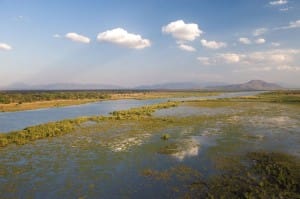
Mvuu Camp overlooks a broad stretch of the Shire River (pronounced Shiree), with a profusion of hippos, crocodiles and the amazing birdlife of the Liwonde National Park.
Mvuu Camp offers a wide range of options including camping, self-catering and full board rates, as well as a range of activities. The activities on offer are the same as those offered at Mvuu Wilderness Lodge, but the camp is better suited either to families or those on a budget, as rates are more reasonable.
Mvuu Camp is a clever mix of stone and canvas chalets and specially-designed family tents, which total 12 units or 48 beds. An impressive thatched dining and lounge area is situated nearby, offering a magnificent vista of the Shire River. Dinners are sometimes held under the stars in a specially constructed boma.
Mvuu Camp also features a new custom-built education and conference centre with facilities for up to 40 delegates or smaller corporate and team building functions.
A particularly rewarding way of arriving at Mvuu Camp is via the boat trip from Liwonde town. This river trip takes guests 30 km along the Shire River, offering an excellent chance to see both game and birds amongst the ever-changing vegetation.
Activities at Mvuu Camp revolve around boating trips on the Shire River and game drives (morning and afternoon/evening). Nature walks and bike rides are also incredibly popular.
The Rhino Tracking Experience is a unique activity that comprises an introduction to the plight of the black rhino, a three-hour guided walk into rhino territory, conducted by armed Rhino Protection Team (RPT) scouts and Wilderness Safaris guides, and ends with a delicious bush breakfast or dinner. In this way, guests have the unparalleled opportunity of tracking black rhino and seeing them on foot, whilst also getting involved in the practicalities of monitoring – all the while contributing to conservation, as 90% of the fee paid goes to rhino conservation projects in Liwonde.
Enthusiasts will be able to participate in virtually non-stop birding around Mvuu Camp.
Chelinda Lodge: Nyika National Park
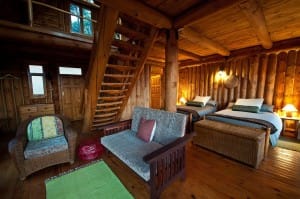
Chelinda Lodge is set against a pocket of hagenia woodland and overlooking vast tracts of Nyika National Park’s rolling grasslands dotted with large herd of roan, eland and zebra. This forest backdrop to Chelinda Lodge provides perfect shelter for an idyllic escape in the highland wilderness of Malawi.
Accommodation at Chelinda Lodge consists of eight log cabins, each with fireplace for those icy highland nights. Chelinda Lodge Cabins are double storey. The ground floor features an open plan bedroom and lounge, with en-suite bathroom, queen-sized beds, wing-back chairs and a veranda. Upstairs there is a viewing area which functions as additional living space and is ideal for children. One of the log cabins is slightly larger, offering ideal accommodation to families.
All the cabins are connected by wooden walkways which are beautifully landscaped on the hillside around Chelinda Lodge. The main building has a convivial dining area around the fireplace, a quiet lounge which opens onto an outside deck for sundowners.
Activities at Chelinda Lodge revolve around day and night nature drives which explore the rolling hills and patches of evergreen forest of the Nyika Plateau. Nature walks and mountain biking are also very popular.

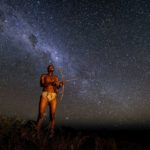
Leave a Reply